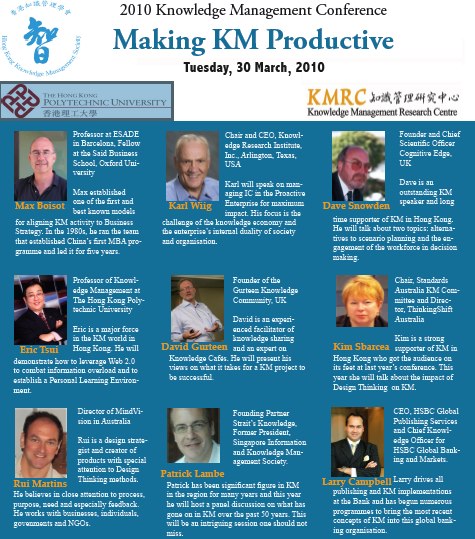Mar 15
The Landscape of Hopes and Fears
Cognitive Edge is doing an interesting crowd sourcing experiment right now using their Sensemaker software. You’re invited to contribute your hopes and fears related to public service provision in the future, and tag those hopes and fears yourself. It’s a global experiment, so as the experiment progresses, we’ll be able to see how diverse or consistent the landscape of the future appears to be to us. Join in here!
Mar 15
Awards Awards
Just a quick plug for two sets of awards (one I’m involved in, and one we support). The iKMS KM Excellence Awards are designed to recognise KM efforts in Singapore, based on self nomination and a careful review by a panel of international experts. iKMS has recognised seven organisations for their KM initiatives over the past two years but nobody has yet achieved a gold – make this the first year for gold! Entries close on 31st March. For more information and the briefing sheet containing the submission template visit the iKMS website.
The StepTwo Designs Intranet Innovation Awards is an award we have supported since its inception. I like this award because it’s designed to capture good intranet ideas that lead to some business value – ie it’s not a benchmarking award that assumes all intranets have to strive for some common standard. And the case studies it produces every year are indeed impressive. These awards are completely international and got recognition at KM World last year. You have a little more time for this closing date: April 23rd.
Go on, get recognised. You know you want to be. It does so much good for everybody’s morale.

Mar 11
Call for Case Presenters: Asia Pacific Business Narrative Conference 2010
Shawn Callahan and I are helping to organise an inaugural “Business Narrative” conference within the International Storytelling Festival in Singapore September 6-8 2010. This is going to be a very practitioner oriented conference looking at approaches and techniques that bring value to the organisation. We’re now launching our first call for case studies to be shared at the conference from the Asia Pacific region (details below). I do hope you’ll pass this post on if you think you know somebody who’ll be interested. Shawn and I will both be happy to answer any questions you have.
Call for Case Studies: Origins – Asia Pacific Business Narrative Conference Sept 6-8 2010 Singapore
In early 2009 we (Shawn Callahan and I) wanted to see if we could put together a conference on storytelling for business. Our concept was for a very practical, workshop-focused conference, designed to help Asia Pacific business people apply story approaches to boost business performance. But we weren’t sure if anyone would come!
So we organised a two-day masterclass on business narrative as part of The Singapore International Storytelling Festival, and the festival did a wonderful job in telling people about the event. We waited anxiously to see if anyone would register. Did Asia Pacific organisations really value storytelling as a legitimate and effective business technique? I called Shawn in Melbourne a couple of weeks after we announced the event: registrations were coming in fast. We were booked out months in advance.
This year we want to build on that success and focus on the many story practitioners in our region to create an event where we can learn from each other while also expanding the awareness of narrative approaches among the region’s organisations. We’re looking for proposals for case study presentations from within the Asia Pacific region to share what you have done and what you have learned.
The conference has three objectives
- To build a network of practitioners to deepen the practice of storytelling and story use in organizations.
- To create awareness of the broad utility of narrative techniques for dealing with business issues, their capacity to humanise the workplace, and to help organisations deal with complexity and
- To inspire leaders to take the first steps in applying narrative techniques in their businesses.
Conference design
The event will have three parts:
Day 1 will be a closed practitioner’s forum for the conference speakers and case study presenters only. We will spend the day sharing what we have learned from a practitioner’s perspective. The day will be designed for dialogue rather than presentations.
Day 2 will be a public conference where practitioners will present case studies that illustrate the effectiveness of story-work; and
Day 3 will consist of a set of 1/2 day workshops to enable attendees to build their business story skills in specific areas such as coaching, organisational change, leadership development and communication.
Do you have a case study to share?
We are seeking expressions of interest to share a case study at the conference. We are particularly interested in stories of working with narrative in organizations, across private, public and non-profit sectors. They should clearly illustrate the value of how stories and storytelling can be used to meet the organisation’s business needs.
Case presenters will:
- Participate in the closed practitioners’ forum on 6 September
- Share their case study in round table discussions in the morning of 7 September
- Offer to share a technique they have successfully used in a “techniques marketplace” session in the afternoon of 7 September
uncertainty.
- How we will select the case studies
We will select case studies based on:
- richness of the case for learning
- transferability of the lessons
- demonstrated impact
- innovative approaches
- geographic representation
- representation of different kinds of organization
Please send a short description (a couple of paragraphs) to both Patrick Lambe (plambe-at-straitsknowledge.com) and Shawn Callahan (shawn-at-anecdote.com.au) before 22nd March. We’re also happy to trade ideas by email or Skype if you want to develop an idea before you decide to put a more formal description together.

Mar 10
Filenaming Conventions and Knowledge Sharing
Sometimes we get so wrapped up in the high flown theory and rhetoric of knowledge sharing, we forget the mundane, almost mechanical ways in which we can enhance it.
At a meeting last week, I was asked if I knew of anyone who had successfully implemented filenaming conventions across their organisation. This agency was interested because they wanted to improve the consistency with which documents are named and stored for common use, thereby improving visibility, access and sharing.
Getting started with a filenaming convention
To support such goals, filenames need to be transparent, meaningful, user-friendly and consistent. This ensures that anyone who reviews a filename should immediately be able to form an accurate expectation about the content of the document.
•Transparent means that the words in the filename accurately summarise the content of the document using language in common use.
•Meaningful means that the words used in the filename usefully distinguish the content of this document from other documents.
•User-friendly means that the filename is easy to read and understand in relation to other filenames in a list, when it is presented in an on-screen window.
•Consistent means that similar principles of filenaming are used by all document creators in a department, so that users do not have to interpret different conventions for the same collection of documents.These principles, by the way, also apply to folder-naming conventions in a traditional folder structure – although with folders, because you are describing collections of content, you are more likely to need a standard taxonomy to provide you with standardised subject-related terms.
Some time back, I wrote a list of high level guidelines for how to approach establishing a common filenaming convention:
- Reduce repetition of common words in file and folder names to a minimum
- Use acronyms only if they are commonly understood among users
- Keep filenames to below 20 characters if you can
- Start the filename with whatever is the key discriminating information for that document type when people want to go find it (eg date, correspondent)
- Construct filenames so that your IT system will display them in a helpful order
- Make sure that all newcomers to your workgroup are introduced to the filenaming conventions
- When you begin any new folder structure or project, agree your filenaming conventions among all content producers in advance
- Enforce consistency by periodic correction of inconsistent naming practices
Filename construction
There is some much more detailed guidance on how to construct transparent, meaningful, user friendly and consistent filenames from a British records management perspective, in guidelines issued by the Universities of Newcastle and Edinburgh respectively (thanks Maish). What is nice about these guidelines is that they explain the rationale for the convention, and give worked examples for both good and bad practice. These guidelines are very easy to adapt, but do localise them to your own context.
Getting the convention bedded down in your organisation
Well at that meeting I recommended Doreen Tan, who has a lot of experience of introducing document management discipline into fairly anarchic or greenfield information environments. She responded to my clients’ enquiry with a very nice, very practical set of suggestions for how to ensure that the convention gets bedded down and actually works. Here is her advice, reproduced with her kind permission:
1. Do not expect 100% takeup rate as it would never happen, but try ways and means to maximise the number.
2. Get buy-in from your senior management at the start; in fact ask them what they would like included in the filenaming convention before implementation.
3. Be able to explain the rationale of including the various components. For example, the version numbers would help staff identify the latest documents if there are 1000 versions being churned out by different people at different times.
4. Leverage on your KM champions or coordinators to help you spread the message and monitor the filenaming at the ground level.
5. Do a 6-month audit to check compliance; highlight examples of non-compliance and keep senior management in the loop. You need to be serious about ensuring compliance.
6. Include the filenaming convention in the staff orientation so that new staff are brainwashed the moment they step into the organisation; have posters stuck on notice board, in the lifts, etc to remind them.
7. Leverage on key managers to help you with the compliance. For example, they will not accept documents that do not conform to the convention.
8. Be ready to set an example at the beginnning of implementation. This means taking the trouble to change the filenaming convention by yourself for a period of time, so that there are live examples that others would hopefully follow.
9. And of course, make sure you follow what you preach so that you will be seen as the ‘authority’ on the topic.If you provide clear guidelines, and follow Doreen’s advice, you will stand a reasonable chance of actually helping to make information more easily navigated and shared. We shouldn’t under-estimate how a simple, clearly explained discipline like this can influence broader attitudes towards knowledge sharing.
Have we missed anything?
Of course, the human spirit has an infinite capacity to transcend our aspirations and our discipline. Here, from “Taxonomist” is a hilarious list of unusual folder names (appropriately organised into a taxonomy) that she has come across in the course of her taxonomy-building work with organisations. My personal favourites are below (but check out the whole post for them all):
- Left Behind
- Called Joe But He Wont Call Me Back_Toss It?
- I No Longer Care
- Jill’s Train wreck
- Hopefully Trash
- This Person is Deceased_Now What?
- Tom’s Files: he was incarcerated and we don’t know what to do
- Dont invest time until someone asks about it
These folder names do express meaning of a sort – we “get” immediately the emotional stance towards the content. They fail every other test, of course, because there’s really no way of forming a reasonable expectation as to the horrors (or treasures) they may contain. But the patent existence of a need to attach emotional significance to our collections of content is one that should give us pause. How do we accommodate that instinct while still serving those broader goals of access and consistency?

Mar 05
KM Treats in Hong Kong
The end of this month sees a tasty KM smorgasbord in Hong Kong, with KM greats Karl Wiig, Max Boisot and Dave Snowden among others (see the leaflet below). I’ll be helping to facilitate an interactive session on the early history of knowledge management (which apparently goes back to the mid 1960s and warrants a separate post). For more on the conference contact les.hales-at-knowledgeworks.com.hk . If you’re an iKMS member, ask for the HKKMS member rate.
Mar 04
KM Volunteers Needed!
The inaugural Youth Olympic Games will be held in Singapore 14-26 August 2010. You may not know, but there’s a lot of knowledge management involved in running major games like this – a country might host the games once in a generation, so won’t get the chance to build up experience. Learning and knowledge transfer between host countries is critical.
Even between events and venues in a single Games, learning has to be very fast. There’s only one chance to get things right. Any mistake should be made no more than once. This process starts on the ground itself, at every event that’s held. During August, every venue and every event will be conducting immediate after action reviews and collecting lessons learned for collation and analysis. So here’s an appeal for help to the Singapore KM community from Doreen Tan, Head of Knowledge Management for the Singapore Youth Olympic Games Organising Committee (SYOGOC):
“We are currently recruiting volunteers for our Games-Time KM Programme. This programme aims to collect and disseminate lessons learnt to workforce on a daily basis during Games Time (14 to 26 Aug 2010) so that there is continuous / just-in-time learning during the entire period. In order for the Programme to work, we would need to deploy volunteers to both competition and non-competition venues to help in the consolidation and ad-hoc facilitation of the AARs. It would be ideal if the volunteers had some knowledge of KM or are professionally involved in KM to some degree.”
Here are more details. Do help if you can! SYOGOC_KM_Volunteers.doc

Feb 11
Delightful MOMster
Exactly a week ago, the Ministry of Manpower‘s (MOM) intranet team jointly organised a session with the Information and Knowledge Management Society (iKMS) to share the former’s experience in revamping their corporate intranet. Here are my notes:
Feb 10
Knowledge Management Explained in Five Disciplines
We welcome Tim Wieringa as a guest blogger to Green Chameleon.
Since 1999, my work has been related to Knowledge Management (KM). Already then, KM was a term that was not well recognised; at the time, we did not label our KM-related consulting services with Knowledge Management. Today I am holding an official position in Knowledge Management, still many people do not grasp the term and have a clear understanding of it. “Knowledge Management” seems to be fuzzy and not specific enough; it does not refer to daily (work) life topics.
Feb 05
From Data, with Love
That most hallowed of mental models and glib explanations, the Data-Information-Knowledge-Wisdom hierarchy has taken a bit of a beating this week. It started in an innocent enough way when, in a discussion about knowledge sharing and generation on the KM4Dev listserve, somebody cited the DIKW model as a way of describing how knowledge is generated in organisations. This provoked Dave Snowden into some sharp but illuminating posts (by the way, if you ever get bored and feel like doing some Dave-baiting, get yourself a false identity, sign up to one of the listserves he frequents, and make an enthusiastic post about DIKW, wisdom management, Six Sigma, Ayn Rand or KM certification - or any combination thereof):
“I would reject the DIKW pyramid, aside from the fact it’s just plain wrong, it’s difficult to explain and leads to bad labels. Better to think that KNOWLEDGE is the way we create INFORMATION from DATA. If we share knowledge then we can understand information.”
“Aside from being linked to a particular period of systems thinking approaches, which we are hopefully moving on from, its very culturally specific. It fails entirely to account of shamanistic knowledge, or the narrative traditions of Sufi philosophy and others. I could go on, but the you get the point; the DIKW pyramid is a culturally limited and inadequate model which has done more harm than good. The SECI model with its de facto focus on codification comes a close second, as I said the other day it’s the model that launched a thousand failed knowledge management initiatives. The main problem is its tendency to get people to think of knowledge as a thing rather than as a flow.”
Dave has posted in the past at greater length on DIKW here and here, and so have I.
However, one worried comment from a listserve member that DIKW was a “well-understood idea within the community” struck me, and prompted a further reply from me - because indeed this hierarchy is extremely well entrenched in the KM (and information science) literature. It’s about as sacred as a sacred cow can get. Why? And should that make it immune to attack posts?
Here’s my reply, slightly modified for a wider audience:

Feb 04
Well I’ll Be…..
What do you call a conference on Data Analysis, Data Quality and Metadata Management? Not the most obvious of acronyms… are they trying to communicate something? Find out here!

